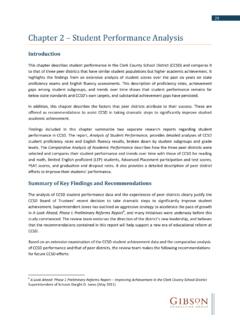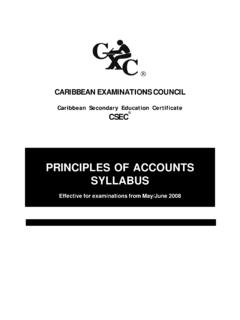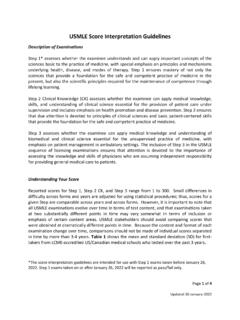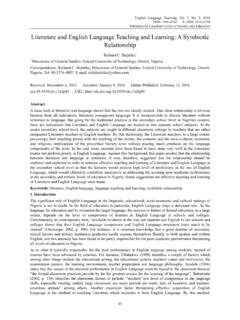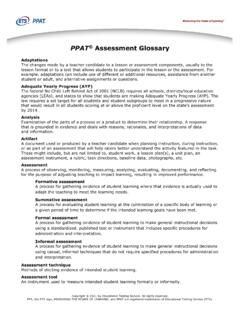Transcription of PROFICIENCY TESTING PT REFERRAL - CMS
1 Clinical Laboratory Improvement Amendments (CLIA) PROFICIENCY TESTING and PT REFERRALDOs and DON TsCongress passed the Clinical Laboratory Improvement Amendments (CLIA) in 1988, establishing quality standards for all laboratory TESTING to ensure the accuracy, reliability and timeliness of patient test results, regardless of where the test was performed. Final CLIA regulations were published in the Federal Register February 28, 1992. The requirements are based on the complexity of the test and not the type of laboratory where the TESTING is performed. Final CLIA Quality Systems laboratory regulations, published by the CDC and CMS, became effective April 24, 2003. Updated CLIA PT REFERRAL regulations, published by CMS, became effective May 2, 2014 and May 12, INFORMATION FOR LABORATORIES PERFORMING NON-WAIVED TESTSF requently Asked Questions about CLIA Requirements for PROFICIENCY TESTING (PT) and PT ReferralThe following information applies only to CMS inspected laboratories.
2 If your laboratory is accredited, you MUST follow the PROFICIENCY TESTING requirements of your accreditation organization. This does not apply to cytology is PROFICIENCY TESTING ? PROFICIENCY TESTING , or PT, is the TESTING of unknown samples sent to a laboratory by an HHS-approved PT program. Most sets of PT samples are sent to participating laboratories on a scheduled basis (usually three times per year). After TESTING , the laboratory reports its sample results back to their PT program. The program grades the results using the CLIA grading criteria and sends the laboratory their scores. CMS and accreditation organizations routinely monitor their laboratories is PT important?PT is important because it is a tool the laboratory can use to verify the accuracy and reliability of its TESTING , and can also be used to validate the entire TESTING process, including competency of your TESTING personnel. Routine reviews of PT reports by the laboratory staff and the laboratory director will alert them to areas of TESTING that are not performing as expected as well as indicate subtle shifts and trends that, over time, would affect their patient I only perform waived TESTING , am I required to perform PT?
3 PT is not required for any test classified as waived. However, enrolling in a PT program and performing PT on your waived test(s) will provide you with an excellent indication of the accuracy and reliability of your waived test results thus improving the quality of TESTING you provide for your patients. It also serves to demonstrate the accuracy of your TESTING if it is ever questioned. You may check the FDA web site to determine whether your test(s) are waived: Please note: If your laboratory enrolls in PT for waived TESTING , all regulations related to PT REFERRAL PT required for all non-waived TESTING ?PT is required for only the limited number of tests found in Subpart I, PROFICIENCY TESTING Programs for Non-Waived TESTING , of the CLIA regulations. If your laboratory 3performs any of the tests found in Subpart I, you must enroll in a CMS-approved PT program and perform PT on each of the tests. We refer to the tests listed in Subpart I as regulated listing of these tests may be found on pages 10-11 of this brochure or can be found on the CLIA website link at the end of this I enroll in any program that offers PT?
4 You must enroll in a CMS-approved PT program. A detailed listing of these programs along with their contact information and the tests for which they are approved is available at: Click on PROFICIENCY TESTING Programs .What must I do to enroll in PT?Using the list on the CLIA web site, choose one (more than one, if your director wishes) of the approved PT program(s) that offer(s) the tests you perform in your laboratory. The PT program will assist you with your enrollment. Call your PT program; the PT representatives will help you enroll properly. Assisting you with proper enrollment is a CLIA requirement for approved PT programs. If more than one PT program is chosen for any given test, the lab must designate which PT program will be used to meet CLIA requirements. The program will notify CMS of your enrollment and the PT TESTING you have signed up to I have more than one TESTING site, do I need to enroll in PT for each site?
5 PT enrollment and participation is required for each CLIA certificate, , PT per certificate (excluding certificate of waiver). If you offer non-waived TESTING at more than one site, but the TESTING is all included under one certificate, you must enroll in an approved PT program(s) for all the regulated analytes covered under that certificate, not for each site. However, PT TESTING should be rotated through all of the sites under the single CLIA certificate. For example, one event is performed by Site A , then the next event would be tested at Site B , and so on until all sites have participated. Continue to rotate events between sites. PT events should never be shared between sites ( , each PT event should not be given to all of the sites to be tested and produce results which are then compared or averaged for submission to the PT program). If you have a separate certificate for each site, you must enroll in PT for the tests performed at each site.
6 It also may be helpful to enroll each site in a different PT provider to avoid any appearance of PT I change my PT program whenever I wish as long as it is CMS-approved?You may not randomly change from one approved PT program(s) to another during the first year of participating with a program. Laboratories must enroll and participate in one approved program or programs for one year before designating a different program. You must also notify CMS before any change in PT my laboratory is new or if I add a new regulated specialty, subspecialty or analyte in the middle of a calendar year, how quickly must I enroll in PT?Laboratories operating under a new certificate and/or adding new regulated TESTING must enroll in PT as soon as possible and complete the PT for the remainder of the I perform unregulated TESTING (tests for which PT is not required), am I required to check the accuracy and reliability of those tests?
7 CLIA requires laboratories to take steps to assure the accuracy of TESTING in lieu of TESTING PT samples. CLIA requires that, at least twice annually, you verify the accuracy of any test or procedure that you perform that is not listed in Subpart do I verify the accuracy of the tests that do not have PT required?A few examples of ways to check the accuracy of TESTING not listed in Subpart I are as follows: Split a patient s specimen (never split a PT sample) with another laboratory that offers the same test(s). Your director should review your results and the other laboratory s results for acceptability. Enroll in PT with a CMS-approved program (Note: If you enroll and participate in PT with a CMS-approved PT program, all regulations related to PT REFERRAL apply regardless if the analyte is listed in Subpart I or certificate type).Are there ever circumstances in PT that require my laboratory to verify the accuracy of regulated tests?
8 Yes there are. There are times when the PT program cannot fully evaluate your samples and you must verify accuracy of those results. You must verify the accuracy of tests for which PT is required if any of the following occur: When your results are submitted to the program after the deadline and are considered a late submission, your laboratory grade will be zero. If you did not test your PT samples at all, your laboratory grade will be zero. There are instances when your grade does not reflect your performance because there was no consensus among all laboratories performing the PT sample(s). You will see this identified by the PT program on your results report as Not Graded or with a code to indicate the reason the sample was not graded. You will be assigned an artificial score of 100% , but that does not reflect your actual performance or the accuracy of your laboratory s I perform the same test using two different test systems, must I perform PT on both test systems?
9 PT is required for only the test system, assay, or examination used as the primary method for patient TESTING during the PT long do I have to test and report the PT samples?The instructions that accompany the PT samples will state the exact date by which you must return your PT results to the program. It is very important to return them on time. A late submission will result in a score of zero (0 %) for the TESTING steps should I take after I have received my PT results from the PT program?Always review your results with your co-workers and your director. Your PT program will include an evaluation for each of the five challenges for each test or analyte in the PT event and will detail the performance of each test system used by the laboratories enrolled with their program. You must evaluate your PT results against the scores published by the PT should be done for all PT results, even those with passing scores.
10 If you receive an 80% score, you should investigate why one of the five samples was outside the acceptable range of results. Document your investigation and what you did to correct the problem that caused the challenge failure. If you discover the issues which led to the 80% score, it could lead to more serious failures in the must I do if I do not get a passing score when the PT program grades my results?Re-review the results that were submitted to the PT program for scoring for any obvious errors (this should have been done prior to submitting your results to the program). Clerical or transcription errors are considered incorrect results. The director of your laboratory, as well as the personnel who performed the TESTING of the PT samples, should compare their PT results with the inter-laboratory comparison evaluations provided by the PT program. You must take remedial actions, , determine the cause of the error or errors, correct it (them), and document your actions.










